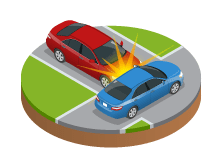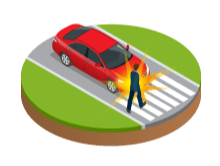Get the cheapest quotes for your car
Compare providers in your area.
Your information is secure
Compare providers in your area.
Your information is secure
The average cost for car insurance in California is $1,194.83 per year or about $100 per month, according to the National Association of Insurance Commissioners (NAIC). That number falls right at the national average, which is about $1,190 per year.
However, the NAIC takes in to account car insurance policies that include both state minimum coverage as well as optional coverage like comprehensive or collision. Because your exact costs depend on factors like your mileage and the risk of car accidents in your area, you could pay a different rate from this average.

15/30/5
$1,194.83
In at-fault states, the driver who caused the accident pays for damages.
To legally drive in California, you’ll need liability coverage that includes coverage limits of at least 15/30/5. These limits tell you how much your insurance will pay for damage or injuries that you cause in an accident.
For uninsured or underinsured motorist coverage, California insurance companies are required to offer it to you, and you must sign a waiver to opt out of buying it.
Let’s go into detail about what’s covered under this state minimum coverage.

California requires at least 15/30 in bodily injury liability limits, which pays up to $15,000 for injuries that you cause to one person and up to $30,000 total if you injure more than one person. This coverage level is low compared to other states that often require 25/50 for this coverage.
Bodily injury coverage applies to other drivers, passengers or pedestrians if you cause the accident. This coverage is important to protect yourself and other people on the road from out-of-pocket costs for medical bills and pain and suffering.

California requires $5,000 for property damage liability, which pays for the other driver’s car damage as well as damaged personal belongings like a smartphone or car accessories. This amount is the lowest coverage requirement for property damage of any state.
You’ll want to think about a higher coverage limit to pay for all the damage you might cause to someone else’s property.

California is an opt-out state for uninsured or underinsured motorist coverage. However, this coverage protects you if you get hit by an uninsured or underinsured driver. In this scenario, this coverage pays for your car’s damage or medical bills to you and your passengers.
These state minimum requirements are some of the lowest in the nation, providing only barebones protection if you get in a car accident. To avoid paying out of pocket, try raising your liability limits based on your budget and adding optional coverage that helps with common types of damage.
Progressive and Mercury bring in the lowest rates for drivers ages 16-34, according to Savvy’s rate data. However, Geico might be your best bet for other drivers, coming in around the state’s average of $100 monthly.
| Age | Allstate | Progressive | Geico | Mercury | USAA |
|---|---|---|---|---|---|
| 16-24 | $159.06 | $151.20 | $181.58 | $227.85 | $177.69 |
| 25-34 | $167.37 | $137.99 | $131.42 | $124.62 | $152.34 |
| 35-44 | $149.56 | $122.47 | $113.72 | $157.90 | $130.00 |
| 45-54 | $132.24 | $116.52 | $106.28 | $109.85 | $138.16 |
| 55-64 | $125.32 | $130.17 | $98.33 | $123.76 | $109.84 |
| 65+ | $138.85 | $85.49 | $84.30 | – | $107.52 |
We found Progressive to give solid value for its car insurance in California, based on several major insurers’ rates from Savvy. Progressive charges an average of $124 per month, although Geico trails closely behind at $128 per month.
| Company | Allstate | Progressive | Geico | Mercury | USAA |
|---|---|---|---|---|---|
| Rate | $148.00 | $123.97 | $128.17 | $146.64 | $135.92 |
You have a mile-long list of car insurance options in California, and each company’s cost can vary wildly based on your address, car and driving record. However, the best choice is the company that offers the widest coverage at a cost that fits your budget.
To narrow down your choices, we recommend these companies that get high praise from locals as well as rating organizations like J.D. Power, Better Business Bureau and AM Best. These companies also offer ample coverage and a variety of discounts for the most value for coverage.
AAA
Finder score
Many California drivers find low car insurance rates alongside AAA's popular roadside assistance plans. You'll get even more bang for your buck if you're already a AAA member or if you know you'll use its extra perks and services.
You can expect a positive experience when working with your AAA agent to find the right coverage for you. The auto club ranks No. 3 for customer satisfaction in California by J.D. Power.
| Telematics | No |
|---|---|
| Gap insurance | Yes |
| Telematics | No |
|---|---|
| Gap insurance | Yes |

State Farm
Finder score
With one-on-one agent support available across the state, it's no wonder that State Farm remains a favorite of California locals. Agents help you choose from its variety of coverage, and bundling policies can save you up to $1,100 per year, according to State Farm's website.
If you consider yourself a safe driver, try State Farm's Drive Safe and Save program. It tracks your driving via an app and offers a discount based on how safely you drive. Either way, manage your policy, file photo claims and find network repair shops in State Farm's user-friendly app.
| Telematics | Drive Safe and Save |
|---|---|
| Gap insurance | No |
| Telematics | Drive Safe and Save |
|---|---|
| Gap insurance | No |

Wawanesa Mutual
Finder score
| Telematics | No |
|---|---|
| Gap insurance | No |
| Telematics | No |
|---|---|
| Gap insurance | No |
Factors are characteristics specific to you that car insurance companies use to set how much you’ll pay for car insurance. The less risky each of your factors is the less you pay, the riskier you are the more you’ll pay. We’ll break down Californian’s rating factors to keep in mind.
| Factor | How it affects your rates |
|---|---|
Age | How old you are is a top factor in determining your car insurance rates. With each passing year, you earn more experience on the road. More experience can equal cheaper rates. Teen drivers pay the most, but rates begin to level off around your 20’s with drivers over 50 paying the least. |
Gender | California is one of seven states that bans the use of gender in calculating car insurance premiums. Insurers rely on factors such as age, location, driving record and what type of car you drive. |
Location | Where you live affects your rates, including where you park your car. High theft rates, high traffic and a high number of uninsured drivers could mean higher rates. California vehicle theft rates stand at 427.6 vehicle thefts per 100,000 inhabitants, according to the FBI’s most recent report on vehicle theft rates. That’s the third-highest vehicle theft rate in the nation and well above the national average of 246 vehicle thefts per 100,000 inhabitants. As for uninsured drivers, 16.6% of Californians on the road are uninsured. That’s more than average for the percent of uninsured drivers in a state according to Insurance Information Institute, with the national average standing at 12.6%. |
Vehicle and mileage | Your car’s make, model and trim directly affect how much you’ll pay for car insurance. Things like its cost, safety ratings, the likelihood of theft and sportiness all help insurers determine its cost to insure. Safer and cheaper vehicles score the lowest rates, with luxury vehicles with higher repair costs resulting in higher premiums. And, the more you’re on the road, the more at-risk you are to get in an accident, which means higher premiums. However, according to the Bureau of Transportation, Californians drive an average of 35.8 miles per day, that’s slightly below the average across the US of 36.1 miles per day. |
Credit score | California is one of five states that can’t use your credit score against you when setting rates. This means you won’t be penalized for bad credit, but you also won’t see any favorable rates for holding a high credit score. |
Coverage | The more coverage you get and the higher limits you choose, the more protection you’ll have and the more you’ll pay in monthly premiums. And, if you opt for full coverage car insurance that includes comprehensive and collision, the amount of your deductible weighs into your costs too, higher deductibles mean lower monthly premiums. |
Driving Record | The better your driving record, the lower your premium. If you’re in an at-fault accident you could see rates increases from 20% to 50%. And DUI’s in California can increase your rate by around 103%. However, California offers a state-mandated Good Driver discount if you have a clean record, which provides 20% off your premium. |
You may be required to file an SR-22 in California if you’re convicted of a serious driving offense, such as a DUI or DWI. The DMV will let you know if you need to file an SR-22, which is a certificate that proves you have enough liability insurance to meet California’s requirements in order to get your license reinstated. Usually, California requires that you maintain your SR-22 for a minimum of three years, but it could be up to 10 years, depending on the conviction. Learn more about SR-22 insurance in California.
Finder surveyed 2,059 American adults about their riskiest driving habits in our latest annual Safe Driving Report. We found that 15.5 million Californians (63.6%) admit to being distracted while driving at least once in the past year.
The top distraction for California drivers is talking on the phone, with 39.2% of those surveyed — about 9.5 million drivers — admitting to answering their cell phone. 18.8% of respondents, representing some 4.6 million drivers, admitted to speeding in 2021. Driving while fatigued is third on the list for distracted driving, with 17.0% of Californians, or 4.2 million drivers, admitting to driving while fatigued.
An estimated 5.1% of California drivers admitted to getting behind the wheel under the influence, quite a risk considering DUI’s in California can increase your rate by around 103%.
| Selections | % of respondents | Estimated number of Californians |
|---|---|---|
| Talking on the phone | 39.20% | 9,549,255 |
| I don’t get distracted | 36.40% | 8,857,280 |
| Speeding | 18.80% | 4,567,035 |
| Driving while fatigued | 17.00% | 4,151,850 |
| Texting | 15.90% | 3,875,060 |
| Arguing | 11.40% | 2,767,900 |
| Fixing appearance | 9.70% | 2,352,715 |
| Driving under the influence | 5.10% | 1,245,555 |
| Other | 4.00% | 968,765 |
In the past ten years, 1,035 Californians died in fatal car crashes over the Thanksgiving, Christmas and New Year’s holiday period. That averages to 103.5 deaths per year, with Thanksgiving being the deadliest holiday to drive at 48.7 fatal crashes per year.
| Holiday period | Average number of California deaths due to fatal crashes over ten years |
|---|---|
| Thanksgiving | 48.7 |
| Christmas | 31.1 |
| New Year’s | 23.7 |
Although our Safe Driving survey found that talking on the phone was the most common type of unsafe driving behavior, most road deaths involved a drunk driver. Finder analysis of NHTSA data found that 37.9% of holiday road deaths in California over the past ten years involved a drunk driver, compared to only 3.0% involving a distracted driver and 2.1% of deaths involving a drowsy driver.
Los Angeles has the highest average number of people killed in fatal crashes with 8.2 deaths on average over the past ten years. That’s more than double San Diego’s death toll which follows with 3.2 average deaths and Sacramento with 1.8 average deaths.
| Rank | City | Thanksgiving | Christmas | New Year’s | Total |
|---|---|---|---|---|---|
| 1 | Los Angeles | 4.4 | 2.4 | 1.4 | 8.2 |
| 2 | San Diego | 0.8 | 1.8 | 0.6 | 3.2 |
| 3 | Sacramento | 1.2 | 0.4 | 0.2 | 1.8 |
| 3 | San Jose | 1.1 | 0.5 | 0.2 | 1.8 |
| 4 | San Bernardino | 0.7 | 0.5 | 0.1 | 1.3 |
| 5 | Oakland | 0.7 | 0.1 | 0.4 | 1.2 |
| 6 | Fresno | 0.7 | 0.1 | 0.3 | 1.1 |
| 6 | Long Beach | 0.6 | 0 | 0.5 | 1.1 |
| 7 | San Francisco | 0.2 | 0.2 | 0.5 | 0.9 |
| 7 | Stockton | 0.4 | 0 | 0.5 | 0.9 |
Natural disasters, heavy traffic, and a diverse landscape – choosing the right coverage in California depend on your individual needs and we have some suggestions.
Since California requires low limits of 15/30/5 for liability coverage, think about raising those limits for your policy. You want to make sure that all the damage you cause is covered by your insurance, especially if someone takes you to court.
Specifically, it may be a good idea to raise your property damage liability since California only requires $5,000 – which is the lowest compared to all other states. When you break it down, $5,000 isn’t a lot to work with. Remember that many brand new vehicles can be worth $40,000 and beyond, so repair costs can add up quickly in a vehicle accident and you could be on the hook for it. Go over how much liability coverage makes sense for you with your insurance agent or financial advisor.
If you’re at fault for an accident, your collision coverage pays for your car damage, but only if you buy this optional coverage. If you commute to work every day or are frequently in heavy traffic, then collision coverage could be well worth the cost. Collision coverage is also a great idea for drivers with expensive vehicles and is required if you’re financing.
With collision coverage, you may qualify for a deductible waiver, which means that your insurance will pay your collision deductible if an uninsured driver damages your car.
Consider collision coverage if . . .
Since car theft happens nearly twice as often in California than it does in other states, comprehensive coverage is worth considering. In fact, California has the third-highest theft rate in the US. If your car is stolen and never recovered, this coverage can step in to help you replace your vehicle.
Comprehensive can also kick in for things like vandalism, hitting an animal, weather damage, and even fire. California is no stranger to wildfires and natural disasters, so comprehensive coverage could be a must-have if you live in an area that’s impacted by unpredictable weather or frequent theft.
Consider this coverage if . . .
While California is an opt-out state for uninsured or underinsured motorist coverage, the Golden State sees more uninsured drivers than average in the US. If you were to get into a vehicle accident with a driver that’s underinsured or has no insurance at all, you may have to get money from them directly or possibly take a legal route. Consider adding this coverage in case you get in an accident with a driver who doesn’t have the proper insurance – especially if you drive a lot.
Consider this coverage if . . .
While optional in California, personal injury protection pays for your or your passengers’ medical bills if you get injured. PIP also pays for lost income or home services during your recovery. Plus, it kicks in no matter who’s at fault in the accident.
Consider this coverage if . . .
See the top insurers by market share nationally that serve in California, according to S&P Global. To help you choose the right insurer for you, we list each company’s ratings from top rating agencies, including:
| Provider | BBB Rating | JD Power Rating | NAIC complaint ratio | National market share % | Finder score | Go to site |
|---|---|---|---|---|---|---|
State Farm | A+ | 847/1000 | 1.93 | 16.2 | ★★★★★ 4/5 | |
Geico | A+ | 832/1000 | 1.42 | 13.6 | ★★★★★ 4/5 | |
Progressive | A+ | 830/1000 | 1.05 | 13.3 | ★★★★★ 4/5 | Get Quotes |
Allstate | A+ | 827/1000 | 2.71 | 10.4 | ★★★★★ 4/5 | |
USAA | A+ | 884/1000 | 1.9 | 6.3 | ★★★★★ 4/5 | |
Farmers | A- | 820/1000 | 1.64 | 4.9 | ★★★★★ 4/5 | |
Liberty Mutual | A+ | 827/1000 | 2.2 | 4.7 | ★★★★★ 4/5 | Get Quotes |
Nationwide | A+ | 814/1000 | 2.08 | 2.3 | ★★★★★ 4/5 | |
Travelers | A+ | 820/1000 | 3.28 | 2 | ★★★★★ 4/5 | |
Kemper | A+ | 784/1000 | 6.42 | 1.5 | ★★★★★ 3/5 |
Of California’s largest cities, Norwalk has the cheapest rates and Pacoima has the most expensive car insurance rates. Pacoima drivers could face rates three times more than Norwalk drivers.
In general, you’re going to pay higher insurance costs to live and commute around a major city like Los Angeles or San Francisco than you would in Redding or Santa Maria.
| Company | Annual car insurance rate |
|---|---|
| Allstate | $1161 |
| 21st century | $1023 |
| Metromile | $517 |
| Progressive | $823 |
| Company | Annual car insurance rate |
|---|---|
| Allstate | $1554 |
| 21st century | $1480 |
| Metromile | $736 |
| Progressive | $1040 |
| Company | Annual car insurance rate |
|---|---|
| Allstate | $1284 |
| 21st century | $1109 |
| Metromile | $594 |
| Progressive | $1011 |
| Company | Annual car insurance rate |
|---|---|
| Allstate | $1128 |
| 21st century | $1152 |
| Metromile | $568 |
| Progressive | $915 |
| Company | Annual car insurance rate |
|---|---|
| Allstate | $1294 |
| 21st century | $1157 |
| Metromile | $638 |
| Progressive | $1073 |
Stay in the loop on vehicle programs that could save you money, as well as important laws that keep you safe and legal on the road.
California’s low-cost insurance program is designed to reduce the number of people driving without insurance. However, you have to meet several eligibility requirements, including:
California is an at-fault state, which means that the driver who caused the car accident pays for the damage. Your insurance company and legal authorities will determine who’s at fault, based on the accident details.
However, California also factors in whether both drivers are partially at fault under a law called pure comparative negligence, according to the legal website Nolo. Under this law, both drivers pay for the percentage of damage that they cause.
For example, if you’re 80% responsible for an accident, your insurance pays 80% of the other driver’s damages. Likewise, the other driver’s insurance pays 20% of your damages.
Any mobile phone use besides hands-free calling is illegal while driving in California. Plus, drivers under 18 years old can’t use a phone while driving even if the drivers use it hands free, according to Nolo.
If you do, you could be fined up to $250 after surcharges are added to the ticket. Officers add surcharges called penalty assessments to most violations.
If you move to California, you’ll need to register your car in the state within 20 days of becoming a resident. To register, fill out the application for registration, bring your car’s current title and registration and show proof of insurance to your Department of Motor Vehicles (DMV). You’ll also need to pass a smog inspection unless your car qualifies to bypass the inspection.
You may qualify for California’s Clean Vehicle Rebate Project if you own certain hydrogen fuel cell, battery electric or hybrid electric vehicles. Zero-emissions motorcycles also may qualify. The rebate typically falls between $1,000 and $4,000, although rebates can go as high as $7,000.
Although you’ll find alternative options for car insurance in California, it’s a good idea to carry a personal policy. Research your insurance options to make sure you have the coverage the state and your circumstances require.
A review of MoneyKey, a lender that offers installment loans and lines of credit up to $3,500 to borrowers with poor credit.
APY stands for “annual percentage yield” and factors in compound interest. See why the difference between APY and interest matters so much.
Interest-bearing accounts passively grow your money. Compare common types of accounts that earn interest and find the best one for you.
Try to keep enough money in your checking account to cover monthly expenses, plus a small cushion. Read more tips here.
The Chime Credit Builder Card can help you build credit without charging interest and doesn’t require a deposit or monthly fee.
Explore cash advance apps like Ualett, perfect for gig workers looking for quick funding, budgeting support and flexible borrowing options.
A review of CashUSA, a loan connection service that may match you with lenders offering loans up to $10,000.
Explore different ways you could earn money playing games with GPT apps, Twitch streaming, esports competitions, and trading cards.
Compare highly rated and legit survey sites for your next side hustle, how to maximize your survey earnings, and how to avoid scams.
Learn how to become user tester, how much you can earn, top platforms for user testing, and how to avoid scams.